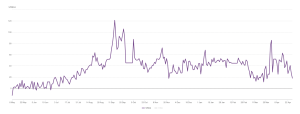Let’s talk about gold
The Bank of Japan’s (BoJ) Post Policy Board Meeting on the 19th of March initiated the first interest rate hike in 17 years. Formerly, the cash rate in Japan was set between -0.1% and 0%. Moving forward, the BoJ will aim to maintain it between 0% and 0.1%, departing from its Negative Interest Rate Policy. Furthermore, the BoJ announced the cessation of its Yield Curve Control framework in addition to ceasing purchases of ETFs and J-REITs, while gradually reducing and ultimately halting corporate bond purchases a year later.
Gold rallies: a recent surge and beyond
Amid economic uncertainties and geopolitical tensions, the recent surge in gold prices has captured the attention of investors worldwide. Gold prices have soared in 2024, reaching unprecedented highs above USD$2,390 per ounce. The rising trend in gold prices started in October 2023, initiated by the eruption of conflict between Israel and Hamas, causing investors to seek a safe haven during this period of instability.
Additionally, the US 10-year yield touched 5% in mid-October and then dropped 50 bps by mid-November on the back of reduced government borrowing estimates for Q4 2023. The US Treasury decided to issue more bills (short-term debts) rather than bonds (long-term debts), contributing to this decrease. In late November 2023, the Fed started to show signs of pivoting dovish, sending the US Treasury 10-year nominal yield down another 50 bps, combined with the drop in October, sending the US 10-year real yield down 40 bps by late December 2023.
The relationship between US real yield and the price of gold is generally considered negative. This means that when US real yields go down, the price of gold tends to go up, and vice versa. Since gold doesn’t offer any interest or dividends, investors primarily invest in it for its potential price appreciation. Hence, when US real yields decline, it means the opportunity cost for investors to hold gold is lower. This makes gold, which offers no interest, relatively more attractive, and its price may rise. However, the relationship doesn’t always hold. In mid-February 2024, the mega-trend of gold started seeing the gold price climb over 20% in two months to unprecedented highs above USD$2,390 per ounce. In the meantime, the US 10-year real yield surged from 1.6% to over 1.9%. This surge is fuelled by multiple factors such as investors have been accumulating gold as a hedge against inflation and geopolitical uncertainties.
Firstly, rising inflation is a key driver, as gold is often seen as a hedge against inflation. Inflation erodes the purchasing power of currencies like the US dollar. As prices rise due to inflation, each dollar buys less. Gold, however, has a historical reputation for maintaining its value over time. Investors buy gold during inflationary periods to protect their wealth from the eroding effects of inflation. Gold has a historical reputation as a safe-haven asset that retains its value during inflationary periods.
Ongoing global tensions can push investors towards gold, seeking its stability in a volatile world. When geopolitical tensions rise, like during wars, trade conflicts, or regional instability, it injects uncertainty into the global market. Investors become risk-averse and seek assets perceived as safe havens, which tend to hold their value or even appreciate during these times.
Finally, global demand was buoyant. Central Banks, particularly in emerging markets, have been significant net buyers of gold. Their continued purchases reflect a desire to diversify their reserves and hedge against potential inflation and economic uncertainty. As highlighted by a recent report from the World Gold Council, central banks added a hefty 290 tonnes of gold to their holdings in the first quarter of 2024. Demand from Chinese investors has been strong, as indicated by the premium gold price in China (below chart). The solid demand may be stemmed from the prolonged underperformance of Chinese equity market and China’s property market has been experiencing a slowdown and downturn in recent times. Given the property’s significance in Chinese investors’ portfolios, the downturn could potentially shift investors’ allocation to gold, which is perceived as a diversifier and driven by its cultural affinity.
Premium / discounts in China and India

The purple line is China and the grey flat line is India.
Source: Bloomberg, ICE Benchmark Administration, Multi Commodity Exchange of India, Reserve Bank of India, Shanghai Gold Exchange, World Gold Council; Disclaimer https://www.gold.org/terms-and-conditions#proprietary-rights. Date as of 26 April 2024.


